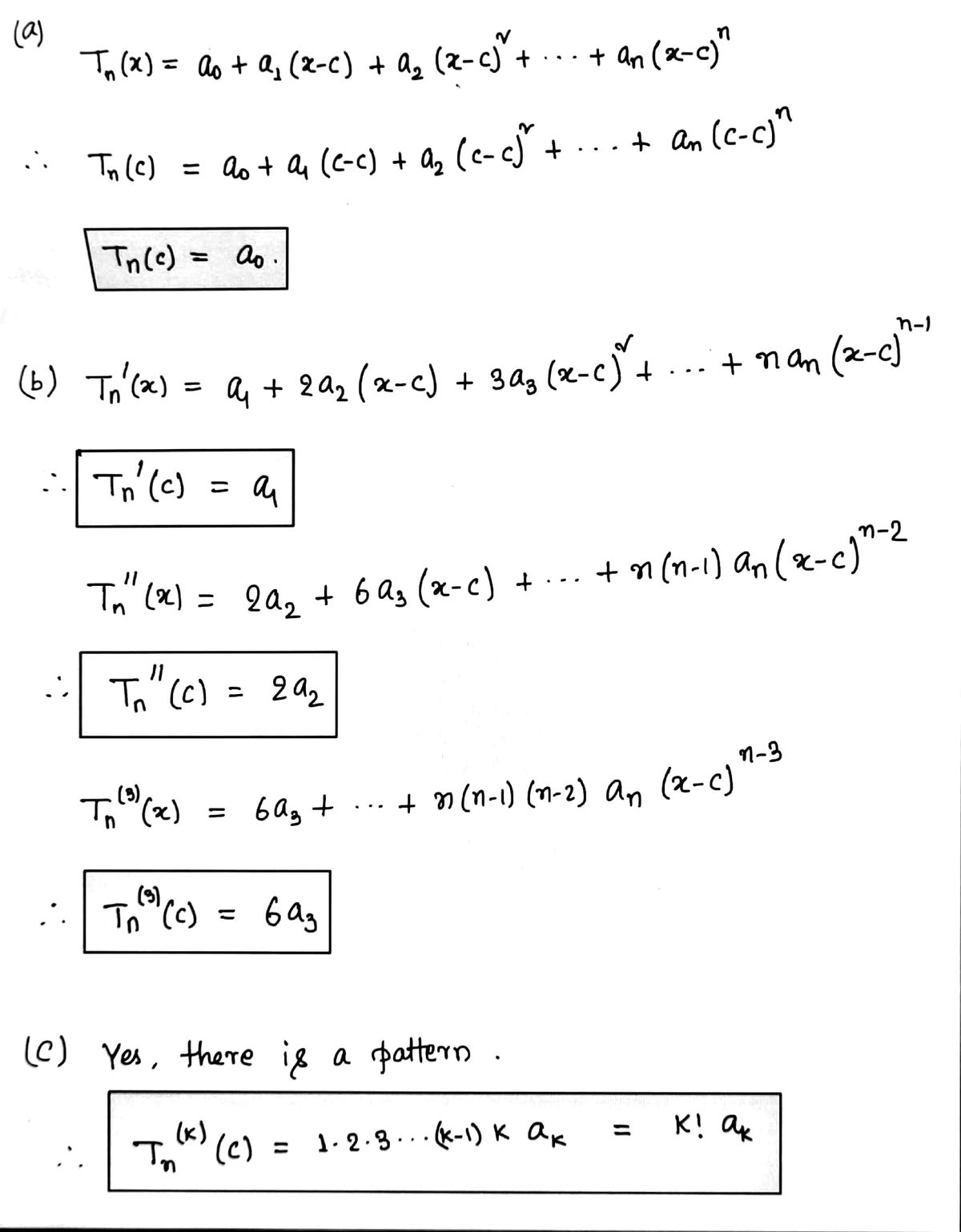The goal of Taylor approximation is to approximate a function f(x) with a polynomial of degree n centered at c: Tn(x) = ao+a₁(x-c) + a₂(x-c)²+...+an(x-c)". f(k) (c) k! In this problem, you will show that a = assuming that f(k) (c) = T() (c), where k = 0,1,2, - - -. (a) If T₁ (x) = a + a₁(x − c) + a₂(x − c)² + + an(rc)", what is T₁(c)? (b) What are T (c), T (c) and T³) (c)? (c) Do you see a pattern? What is T) (c)? (d) Using the equality: f(k) (c) = T(k) (c) and the result in (c), show that a = f(k) (c) k!
The goal of Taylor approximation is to approximate a function f(x) with a polynomial of degree n centered at c: Tn(x) = ao+a₁(x-c) + a₂(x-c)²+...+an(x-c)". f(k) (c) k! In this problem, you will show that a = assuming that f(k) (c) = T() (c), where k = 0,1,2, - - -. (a) If T₁ (x) = a + a₁(x − c) + a₂(x − c)² + + an(rc)", what is T₁(c)? (b) What are T (c), T (c) and T³) (c)? (c) Do you see a pattern? What is T) (c)? (d) Using the equality: f(k) (c) = T(k) (c) and the result in (c), show that a = f(k) (c) k!
Advanced Engineering Mathematics
10th Edition
ISBN:9780470458365
Author:Erwin Kreyszig
Publisher:Erwin Kreyszig
Chapter2: Second-order Linear Odes
Section: Chapter Questions
Problem 1RQ
Related questions
Question
![The goal of Taylor approximation is to approximate a function \( f(x) \) with a polynomial of degree \( n \) centered at \( c \):
\[ T_n(x) = a_0 + a_1(x-c) + a_2(x-c)^2 + \cdots + a_n(x-c)^n. \]
In this problem, you will show that \( a_k = \frac{f^{(k)}(c)}{k!} \), assuming that \( f^{(k)}(c) = T_n^{(k)}(c) \), where \( k = 0,1,2,\ldots \).
(a) If \( T_n(x) = a_0 + a_1(x-c) + a_2(x-c)^2 + \cdots + a_n(x-c)^n \), what is \( T_n(c) \)?
(b) What are \( T_n'(c) \), \( T_n''(c) \), and \( T_n^{(3)}(c) \)?
(c) Do you see a pattern? What is \( T_n^{(k)}(c) \)?
(d) Using the equality: \( f^{(k)}(c) = T_n^{(k)}(c) \) and the result in (c), show that \( a_k = \frac{f^{(k)}(c)}{k!} \).](/v2/_next/image?url=https%3A%2F%2Fcontent.bartleby.com%2Fqna-images%2Fquestion%2Fa3b47e7c-f6ee-4dde-9ef1-0f8b8a2d2829%2Fa73409ef-2ef1-4f23-bff0-98d984de9609%2Fu60khia_processed.png&w=3840&q=75)
Transcribed Image Text:The goal of Taylor approximation is to approximate a function \( f(x) \) with a polynomial of degree \( n \) centered at \( c \):
\[ T_n(x) = a_0 + a_1(x-c) + a_2(x-c)^2 + \cdots + a_n(x-c)^n. \]
In this problem, you will show that \( a_k = \frac{f^{(k)}(c)}{k!} \), assuming that \( f^{(k)}(c) = T_n^{(k)}(c) \), where \( k = 0,1,2,\ldots \).
(a) If \( T_n(x) = a_0 + a_1(x-c) + a_2(x-c)^2 + \cdots + a_n(x-c)^n \), what is \( T_n(c) \)?
(b) What are \( T_n'(c) \), \( T_n''(c) \), and \( T_n^{(3)}(c) \)?
(c) Do you see a pattern? What is \( T_n^{(k)}(c) \)?
(d) Using the equality: \( f^{(k)}(c) = T_n^{(k)}(c) \) and the result in (c), show that \( a_k = \frac{f^{(k)}(c)}{k!} \).
Expert Solution
Step 1

Step by step
Solved in 2 steps with 2 images

Recommended textbooks for you

Advanced Engineering Mathematics
Advanced Math
ISBN:
9780470458365
Author:
Erwin Kreyszig
Publisher:
Wiley, John & Sons, Incorporated

Numerical Methods for Engineers
Advanced Math
ISBN:
9780073397924
Author:
Steven C. Chapra Dr., Raymond P. Canale
Publisher:
McGraw-Hill Education

Introductory Mathematics for Engineering Applicat…
Advanced Math
ISBN:
9781118141809
Author:
Nathan Klingbeil
Publisher:
WILEY

Advanced Engineering Mathematics
Advanced Math
ISBN:
9780470458365
Author:
Erwin Kreyszig
Publisher:
Wiley, John & Sons, Incorporated

Numerical Methods for Engineers
Advanced Math
ISBN:
9780073397924
Author:
Steven C. Chapra Dr., Raymond P. Canale
Publisher:
McGraw-Hill Education

Introductory Mathematics for Engineering Applicat…
Advanced Math
ISBN:
9781118141809
Author:
Nathan Klingbeil
Publisher:
WILEY

Mathematics For Machine Technology
Advanced Math
ISBN:
9781337798310
Author:
Peterson, John.
Publisher:
Cengage Learning,

